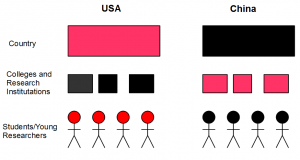
BGI Model
Few days back, we were chatting with another researcher, who completed a genome sequencing project in collaboration with BGI. He said that several groups started working on the same organism, and they had to finish first to publish in Science or Nature. So, they went along with BGI.
His main reason for collaborating with BGI was bioinformatics. BGI did a smart thing and hired about 500-1000 young kids (17-18 yo) to work on the data. Those kids are computer savvy, and can run all kinds of analysis. The cost of the project came to be roughly US $1M, and was provided by the US collaborator. With that money, they were able to hire many more bioinformaticians in China than other competing projects, and indeed managed to finish first.
We also chatted about the factory-like environment at BGI also discussed in this Nature News article. Like all other Chinese companies, BGI has a huge dorm inside its campus, where the kids stay together. I think some of those were covered in recent articles on Apple, although the generally negative spin painted by US media is misleading. Chinese dorms look like paradise compared to our undergraduate dorms in India.
After the discussion, we are even more convinced that the center of science is moving from USA to Asia. Three reasons -
a) USA is not dynamic and old people controlling funding are too skeptical about to accept new ideas. For example, in USA the most innovative part of biology is relegated to ‘core facilities’, which the older professors in biology departments keep at arms length as a ‘service’.
b) USA is over-regulated and bureaucratic. Most of our collaborators complain about the amount of bureaucratic hurdles they go through to get even frogs or fishes in their labs. When we were working on honey bee few years back, a collaborator shipped cDNA samples from Australia and the sample got stuck at San Francisco airport for some terrorist rule. In the most recent change,
For researchers who rely on lab animals shipped from distant sources, and for the companies that breed them, the options are narrowing again. This week, People for the Ethical Treatment of Animals (PETA) will announce that it has obtained written assurances from the worlds two largest air-cargo carriers, FedEx and UPS, that they will not transport mammals for laboratory use. UPS says that it is also planning to further restrict an exemption that allows the transport of amphibians, fish, insects and other non-mammals.
c) USA is too hierarchical with young people sent to multiple layers PhD, postdocs, etc, which are completely useless with rapidly changing technology.
The above points are debatable, but one interesting contrast between the two countries is highlighted in the following cartoon figure (Red means with debt, and black means flush with money). It is where the debts are located.

The topmost node of the tree is red in USA, and black in China. Institutions
are at the opposite end. BGI, for example, operates by taking a 10-billion-
renminbi loan (US $1.57B) from the China Development Bank, whereas most non-
profit institutions in USA are in the black based on their sovereign
wealth fund endowment fund. Students, in USA, are stuck with highly
regressive student loans pushed by the federal government, and the loans
cannot be canceled in bankruptcy. We do not know, whether the BGI researchers
are paid in debt, but we doubt it.